boot CITROEN E-MEHARI 2023 Owners Manual
[x] Cancel search | Manufacturer: CITROEN, Model Year: 2023, Model line: E-MEHARI, Model: CITROEN E-MEHARI 2023Pages: 84, PDF Size: 3.48 MB
Page 4 of 84
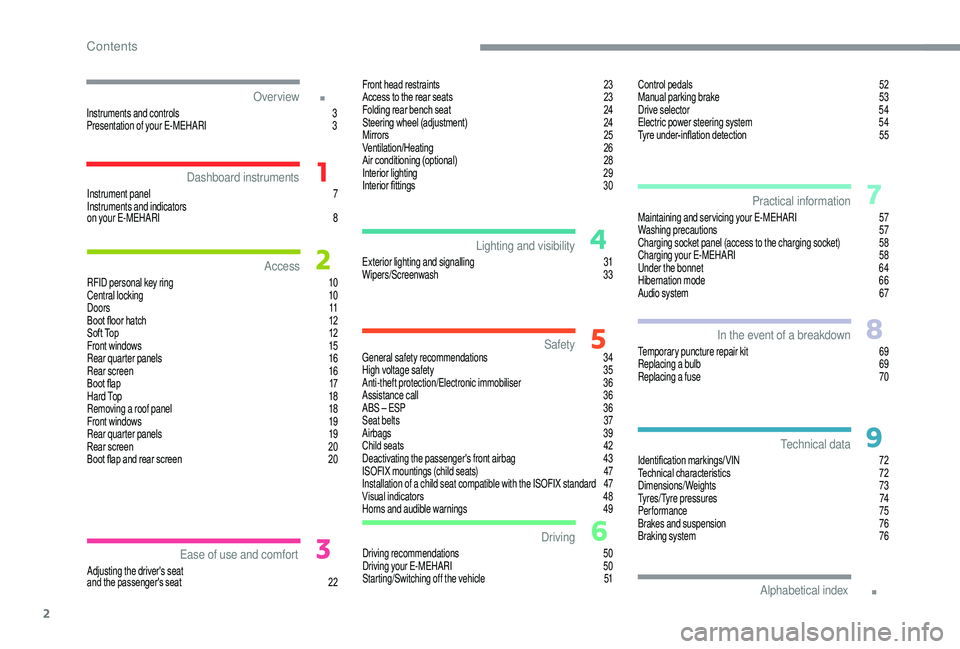
2
.
.
Driving recommendations 50
Driving your E-MEHARI 5 0
Starting/Switching off the vehicle
5
1Maintaining and servicing your E-MEHARI
5
7
Washing precautions
5
7
Charging socket panel (access to the charging socket)
5
8
Charging your E-MEHARI
5
8
Under the bonnet
6
4
Hibernation mode
6
6
Audio system
6
7
Temporary puncture repair kit
6
9
Replacing a bulb
6
9
Replacing a fuse
7
0
Identification markings/VIN
7
2
Technical characteristics
7
2
Dimensions/ Weights
73
Tyres/Tyre pressures
7
4
Performance
75
Brakes and suspension
7
6
Braking system
7
6
Instrument panel
7
I
nstruments and indicators
on your E-MEHARI
8
R
FID personal key ring
1
0
Central locking
1
0
D o o r s
11
Boot floor hatch
1
2
Soft Top
1
2
Front windows
1
5
Rear quarter panels
1
6
Rear screen
1
6
Boot flap
1
7
Hard Top
1
8
Removing a
roof panel
1
8
Front windows
1
9
Rear quarter panels
1
9
Rear screen
2
0
Boot flap and rear screen
2
0
Adjusting the driver's seat
and the passenger's seat
2
2 Exterior lighting and signalling
3
1
Wipers/Screenwash
33
G
eneral safety recommendations
3
4
High voltage safety
3
5
Anti-theft protection/Electronic immobiliser
3
6
Assistance call
3
6
ABS – ESP
3
6
Seat belts
3
7
Airbags
39
Child seats
4
2
Deactivating the passenger's front airbag
4
3
ISOFIX mountings (child seats)
4
7
Installation of a child seat compatible with the ISOFIX standard
4
7
Visual indicators
4
8
Horns and audible warnings
4
9
Over view
Dashboard instruments
Access
Ease of use and comfort Safety
Driving Practical information
In the event of a
breakdown
Technical data
Alphabetical index
Lighting and visibility
Instruments and controls 3
P resentation of your E-MEHARI 3F
ront head restraints
2
3
Access to the rear seats
2
3
Folding rear bench seat 2 4
Steering wheel (adjustment) 2 4
Mirrors
2
5
Ventilation/Heating
2
6
Air conditioning (optional)
2
8
Interior lighting
2
9
Interior fittings
3
0Control pedals
5
2
Manual parking brake
5
3
Drive selector 5 4
Electric power steering system 5 4
Tyre under-inflation detection
5
5
Contents
Page 10 of 84
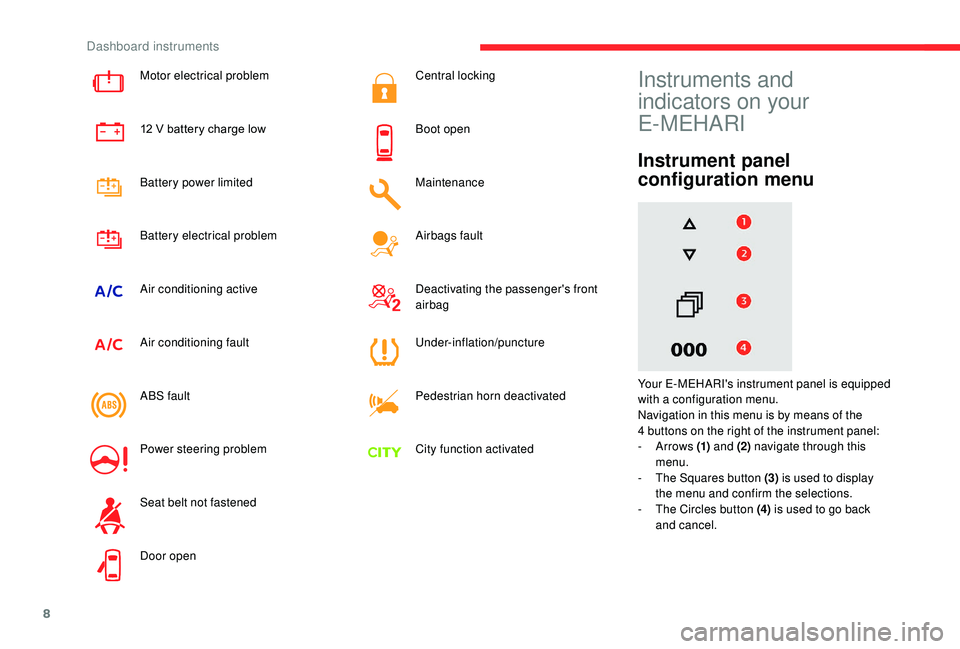
8
Central locking
Boot open
Maintenance
Airbags fault
Deactivating the passenger's front
airbag
Under-inflation/puncture
Pedestrian horn deactivated
City function activatedInstruments and
indicators on your
E-MEHARI
Instrument panel
configuration menu
Your E-MEHARI's instrument panel is equipped
with a configuration menu.
Navigation in this menu is by means of the
4
buttons on the right of the instrument panel:
-
Arrows (1) and (2) navigate through this
menu.
-
T
he Squares button (3) is used to display
the menu and confirm the selections.
-
T
he Circles button (4) is used to go back
and cancel.
Motor electrical problem
12
V battery charge low
Battery power limited
Battery electrical problem
Air conditioning active
Air conditioning fault
ABS fault
Power steering problem
Seat belt not fastened
Door open
Dashboard instruments
Page 12 of 84
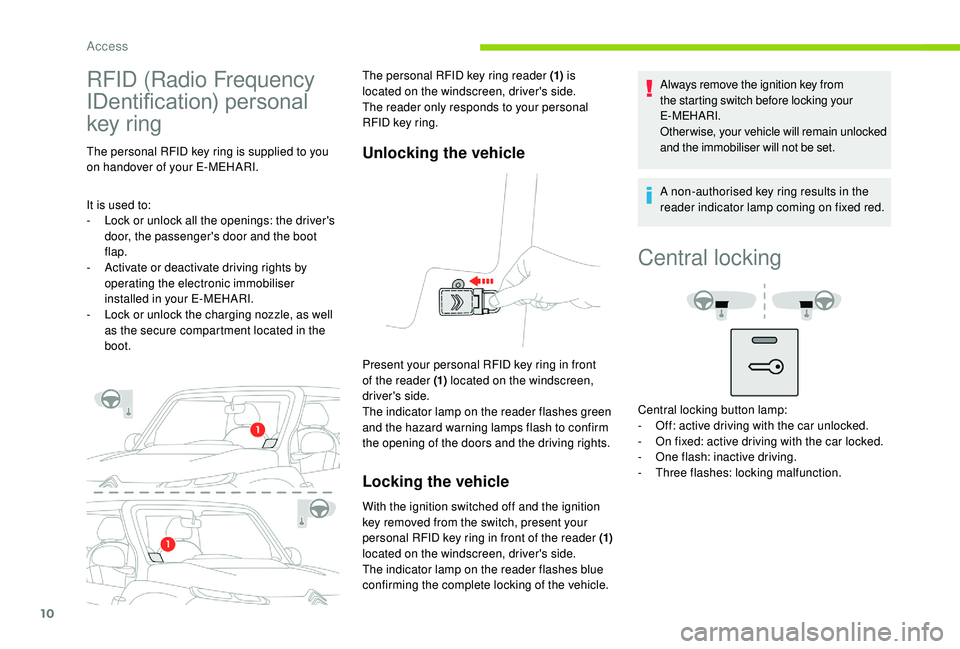
10
RFID (Radio Frequency
IDentification) personal
key ring
The personal RFID key ring is supplied to you
on handover of your E-MEHARI.
It is used to:
-
L
ock or unlock all the openings: the driver's
door, the passenger's door and the boot
flap.
-
A
ctivate or deactivate driving rights by
operating the electronic immobiliser
installed in your E-MEHARI.
-
L
ock or unlock the charging nozzle, as well
as the secure compartment located in the
boot. The personal RFID key ring reader (1)
is
located on the windscreen, driver's side.
The reader only responds to your personal
RFID key ring.Unlocking the vehicle
Present your personal RFID key ring in front
of the reader (1) located on the windscreen,
driver's side.
The indicator lamp on the reader flashes green
and the hazard warning lamps flash to confirm
the opening of the doors and the driving rights.
Locking the vehicle
With the ignition switched off and the ignition
key removed from the switch, present your
personal RFID key ring in front of the reader (1)
located on the windscreen, driver's side.
The indicator lamp on the reader flashes blue
confirming the complete locking of the vehicle. Always remove the ignition key from
the starting switch before locking your
E-MEHARI.
Otherwise, your vehicle will remain unlocked
and the immobiliser will not be set.
A non-authorised key ring results in the
reader indicator lamp coming on fixed red.
Central locking
Central locking button lamp:
-
O ff: active driving with the car unlocked.
-
O
n fixed: active driving with the car locked.
-
O
ne flash: inactive driving.
-
T
hree flashes: locking malfunction.
Access
Page 13 of 84
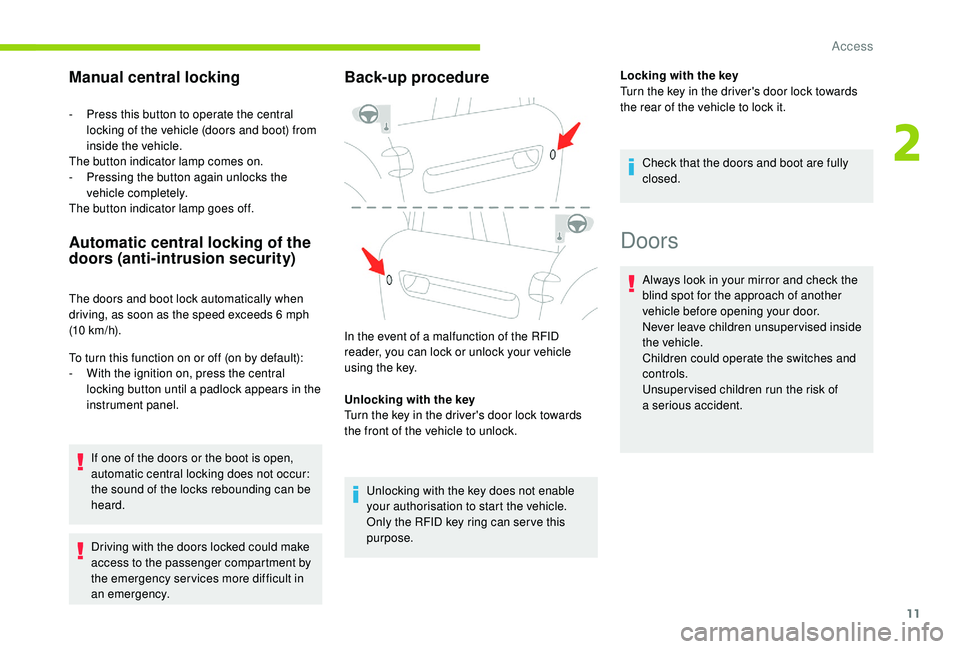
11
Manual central locking
- Press this button to operate the central locking of the vehicle (doors and boot) from
inside the vehicle.
The button indicator lamp comes on.
-
P
ressing the button again unlocks the
vehicle completely.
The button indicator lamp goes off.
Automatic central locking of the
doors (anti-intrusion security)
The doors and boot lock automatically when
driving, as soon as the speed exceeds 6 mph
(10
km/h).
To turn this function on or off (on by default):
-
W
ith the ignition on, press the central
locking button until a
padlock appears in the
instrument panel.
If one of the doors or the boot is open,
automatic central locking does not occur:
the sound of the locks rebounding can be
heard.
Driving with the doors locked could make
access to the passenger compartment by
the emergency services more difficult in
an emergency.
Back-up procedure
In the event of a malfunction of the RFID
r eader, you can lock or unlock your vehicle
using the key.
Unlocking with the key
Turn the key in the driver's door lock towards
the front of the vehicle to unlock.
Unlocking with the key does not enable
your authorisation to start the vehicle.
Only the RFID key ring can ser ve this
purpose. Locking with the key
Turn the key in the driver's door lock towards
the rear of the vehicle to lock it.
Check that the doors and boot are fully
closed.
Doors
Always look in your mirror and check the
blind spot for the approach of another
vehicle before opening your door.
Never leave children unsuper vised inside
the vehicle.
Children could operate the switches and
controls.
Unsuper vised children run the risk of
a
serious accident.
2
Access
Page 14 of 84
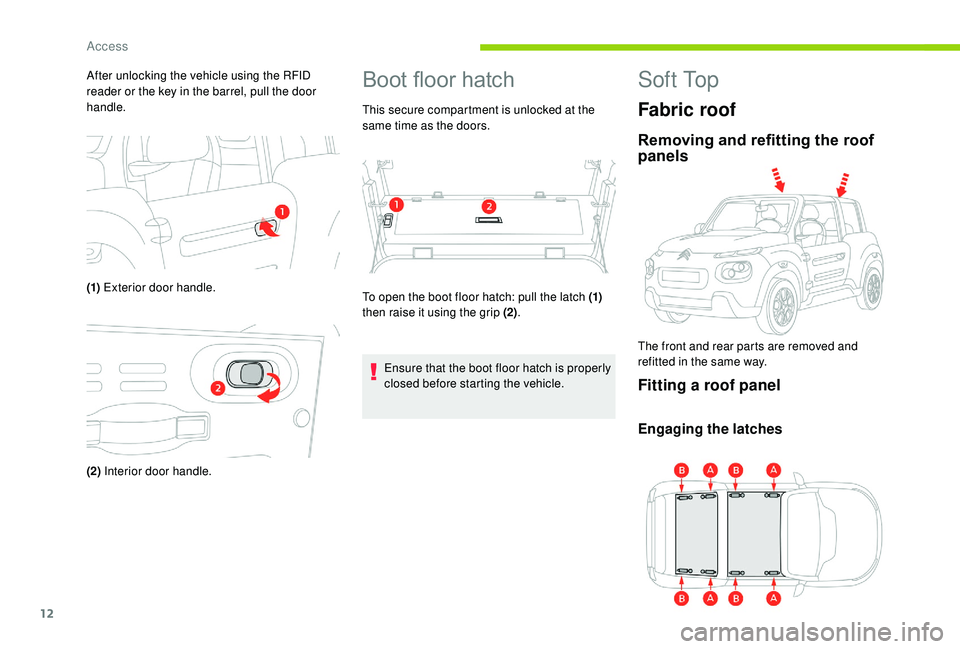
12
After unlocking the vehicle using the RFID
reader or the key in the barrel, pull the door
handle.
(1) Exterior door handle.
(2) Interior door handle.Boot floor hatch
This secure compartment is unlocked at the
same time as the doors.
To open the boot floor hatch: pull the latch (1)
then raise it using the grip (2) .
Ensure that the boot floor hatch is properly
closed before starting the vehicle.
S o f t To p
Fabric roof
Removing and refitting the roof
panels
The front and rear parts are removed and
refitted in the same way.
Fitting a roof panel
Engaging the latches
Access
Page 17 of 84
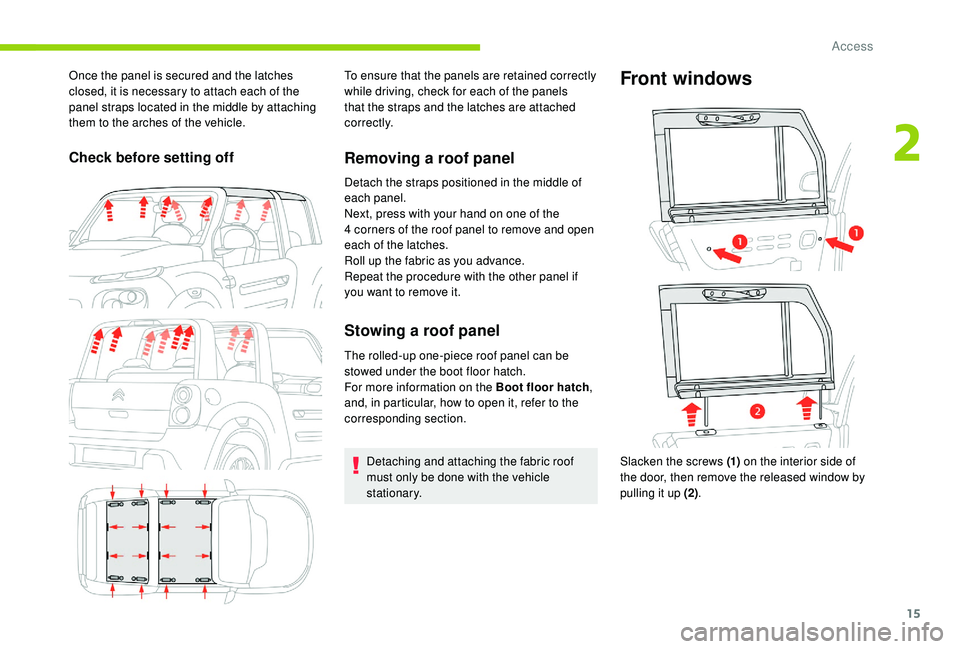
15
Once the panel is secured and the latches
closed, it is necessary to attach each of the
panel straps located in the middle by attaching
them to the arches of the vehicle.
Check before setting off
To ensure that the panels are retained correctly
while driving, check for each of the panels
that the straps and the latches are attached
c o r r e c t l y.
Removing a roof panel
Detach the straps positioned in the middle of
each panel.
Next, press with your hand on one of the
4 corners of the roof panel to remove and open
each of the latches.
Roll up the fabric as you advance.
Repeat the procedure with the other panel if
you want to remove it.
Stowing a roof panel
The rolled-up one-piece roof panel can be
stowed under the boot floor hatch.
For more information on the Boot floor hatch ,
and, in particular, how to open it, refer to the
corresponding section.
Detaching and attaching the fabric roof
must only be done with the vehicle
stationary.
Front windows
Slacken the screws (1) on the interior side of
the door, then remove the released window by
pulling it up (2) .
2
Access
Page 19 of 84
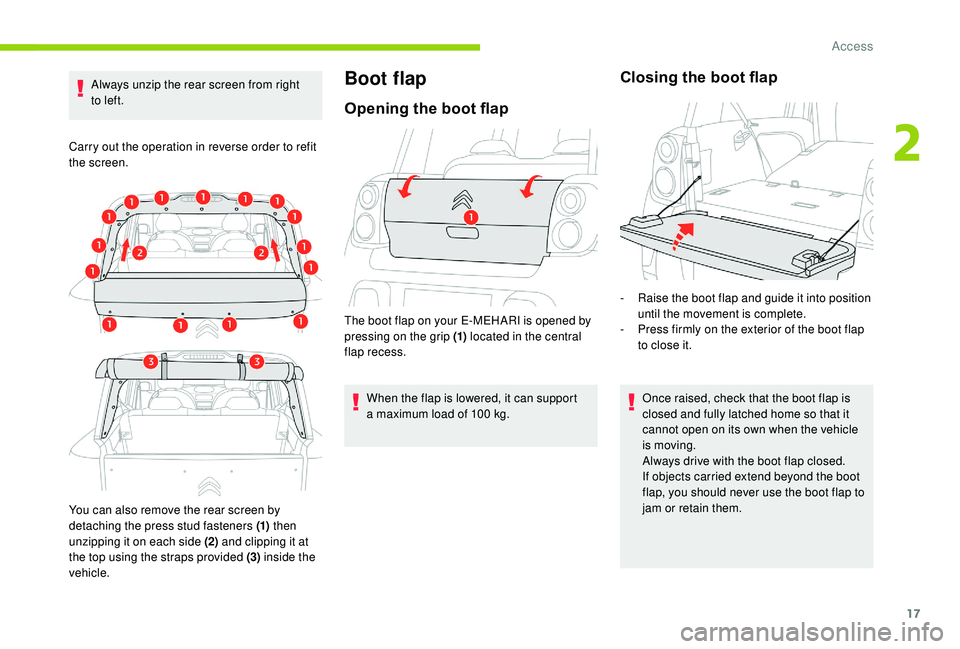
17
Always unzip the rear screen from right
to left.
Carry out the operation in reverse order to refit
the screen.
You can also remove the rear screen by
detaching the press stud fasteners (1) then
unzipping it on each side (2) and clipping it at
the top using the straps provided (3) inside the
vehicle.Boot flap
Opening the boot flap
The boot flap on your E-MEHARI is opened by
pressing on the grip (1) located in the central
flap recess.
When the flap is lowered, it can support
a
maximum load of 100 kg.
Closing the boot flap
- Raise the boot flap and guide it into position until the movement is complete.
-
P
ress firmly on the exterior of the boot flap
to close it.
Once raised, check that the boot flap is
closed and fully latched home so that it
cannot open on its own when the vehicle
is moving.
Always drive with the boot flap closed.
If objects carried extend beyond the boot
flap, you should never use the boot flap to
jam or retain them.
2
Access
Page 22 of 84
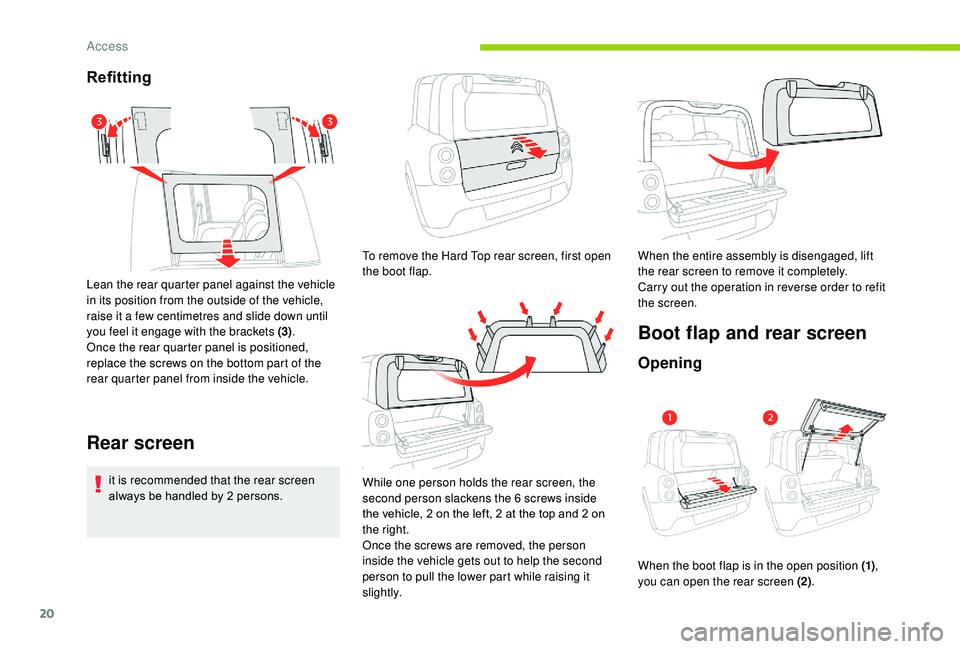
20
Refitting
Lean the rear quarter panel against the vehicle
in its position from the outside of the vehicle,
raise it a few centimetres and slide down until
you feel it engage with the brackets (3).
Once the rear quarter panel is positioned,
replace the screws on the bottom part of the
rear quarter panel from inside the vehicle.
Rear screen
it is recommended that the rear screen
always be handled by 2 persons.To remove the Hard Top rear screen, first open
the boot flap.
While one person holds the rear screen, the
second person slackens the 6
screws inside
the vehicle, 2
on the left, 2 at the top and 2 on
the right.
Once the screws are removed, the person
inside the vehicle gets out to help the second
person to pull the lower part while raising it
s l i g ht l y. When the entire assembly is disengaged, lift
the rear screen to remove it completely.
Carry out the operation in reverse order to refit
the screen.
Boot flap and rear screen
Opening
When the boot flap is in the open position (1)
,
you can open the rear screen (2) .
Access
Page 23 of 84
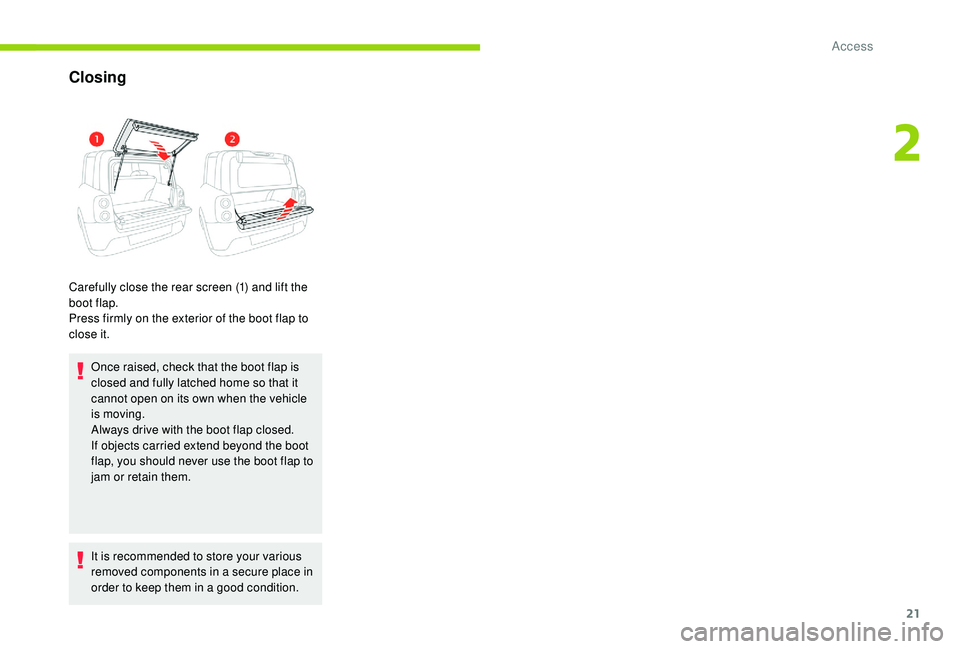
21
Closing
Carefully close the rear screen (1) and lift the
boot flap.
Press firmly on the exterior of the boot flap to
close it.Once raised, check that the boot flap is
closed and fully latched home so that it
cannot open on its own when the vehicle
is moving.
Always drive with the boot flap closed.
If objects carried extend beyond the boot
flap, you should never use the boot flap to
jam or retain them.
It is recommended to store your various
removed components in a
secure place in
order to keep them in a
good condition.
2
Access
Page 71 of 84
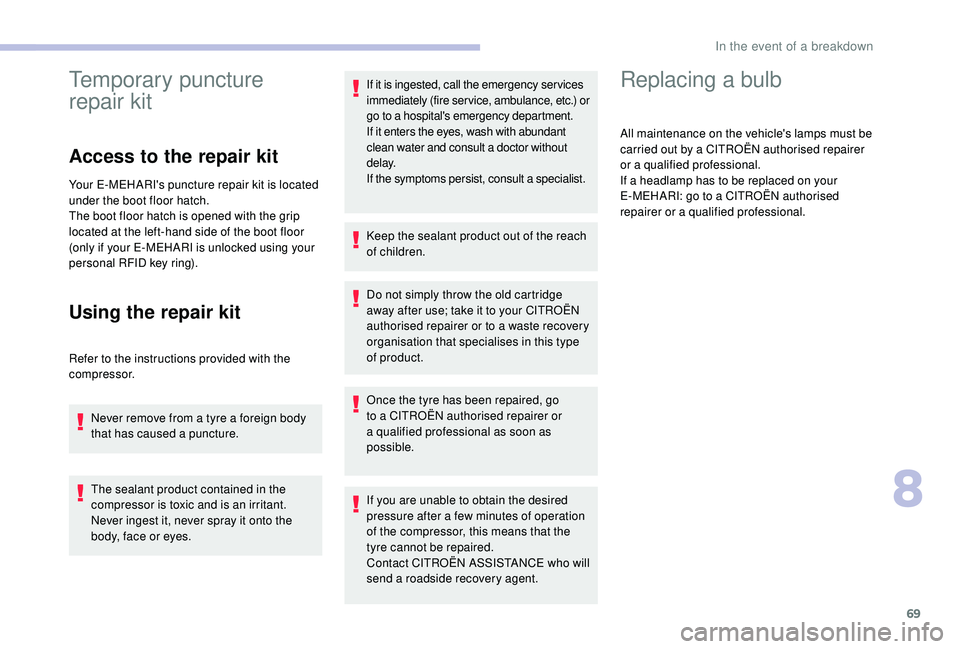
69
Temporary puncture
repair kit
Access to the repair kit
Your E-MEHARI's puncture repair kit is located
under the boot floor hatch.
The boot floor hatch is opened with the grip
located at the left-hand side of the boot floor
(only if your E-MEHARI is unlocked using your
personal RFID key ring).
Using the repair kit
Refer to the instructions provided with the
compressor.Never remove from a
tyre a foreign body
that has caused a puncture.
The sealant product contained in the
compressor is toxic and is an irritant.
Never ingest it, never spray it onto the
body, face or eyes. If it is ingested, call the emergency services
immediately (fire service, ambulance, etc.) or
go to a
hospital's emergency department.
If it enters the eyes, wash with abundant
clean water and consult a doctor without
d e l ay.
If the symptoms persist, consult a specialist.
Keep the sealant product out of the reach
of children.
Do not simply throw the old cartridge
away after use; take it to your CITROËN
authorised repairer or to a waste recovery
organisation that specialises in this type
of product.
Once the tyre has been repaired, go
to a
CITROËN authorised repairer or
a
qualified professional as soon as
possible.
If you are unable to obtain the desired
pressure after a
few minutes of operation
of the compressor, this means that the
tyre cannot be repaired.
Contact CITROËN ASSISTANCE who will
send a
roadside recovery agent.
Replacing a bulb
All maintenance on the vehicle's lamps must be
carried out by a
CITROËN authorised repairer
or a
qualified professional.
If a
headlamp has to be replaced on your
E-MEHARI: go to a
CITROËN authorised
repairer or a qualified professional.
8
In the event of a breakdown